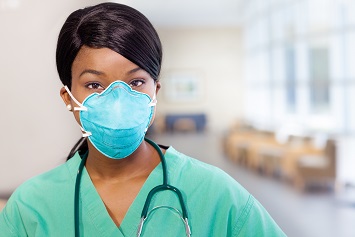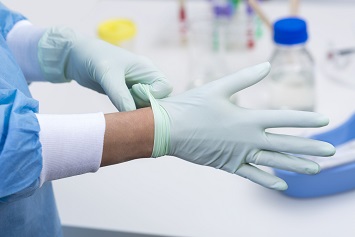The ongoing coronavirus (COVID-19) pandemic has brought a renewed focus on personal protective equipment (PPE) for healthcare workers. COVID-19 is a respiratory disease caused by a novel coronavirus—referred to as 2019-nCOV or SARS-CoV-2—first identified in Wuhan City, China, in December 2019.
The use of PPE can help protect the health and safety of healthcare workers themselves, as well as help prevent the infection of other clients, patients, or visitors.
Concern about the spread of COVID-19 has resulted in a high demand for both surgical masks and N95 respirators. Decreases in exports from countries such as China, India, and Taiwan, along with increased worldwide demand due to the outbreak, has resulted in an increased volume of orders and challenges in meeting demands, PPE manufacturers have reported.
Plans are underway for a surge in manufacturing globally, according to the Centers for Disease Control and Prevention (CDC).
Surgical masks provide barrier protection to prevent sick individuals from infecting others. Surgical masks are not designed for use as particulate respirators and do not provide the respiratory protection an N95 respirator does.
The U.S. Food and Drug Administration (FDA) regulates surgical masks and respirators used in healthcare facilities under its medical device authority. The National Institute for Occupational Safety and Health (NIOSH) evaluates and approves all respirators. Most N95 respirators in the United States are manufactured and sold for construction and industrial use rather than healthcare. NIOSH tests N95 respirators intended for healthcare use under a memorandum of understanding with the FDA. However, such respirators must meet additional FDA test requirements.
To increase the supply of respirators available for healthcare workers, the FDA granted an emergency CDC request to allow the use of NIOSH-approved industrial respirators during the COVID-19 outbreak.
Industrial respirators are not tested to meet FDA requirements for healthcare use.
The CDC and other public health authorities also are advocating limited reuse of N95 respirators and use of certain N95 respirators beyond their labeled expiration date. The CDC and state departments of public health have issued guidelines to optimize the current supply of N95 respirators. Other suggestions include using elastomeric half-mask, full-facepiece, and powered air-purifying respirators (PAPRs) that can be disinfected and reused multiple times.
The CDC and FDA stressed that there is no added health benefit for the general American public to wear a respiratory protective device (such as an N95 respirator). The CDC recommends everyday preventive actions, such as cough and sneeze etiquette, hand-washing, and social distancing, as the immediate health risk from COVID-19 is considered low.
High demand for respiratory protection also has opened up opportunities for fraud and counterfeit products. PPE manufacturer 3M Company reported a rise in fraud and counterfeiting in connection with the COVID-19 pandemic. Certain businesses and individuals who are not authorized dealers or distributors have fraudulently represented themselves as affiliated with 3M and are selling counterfeit 3M products.
3M reported instances of respirators sold individually or in bulk bags or boxes of loose respirators without 3M packaging. Counterfeit respirators also have been sold with blocked valves, missing straps, misspelled words, and strange odors.
PPE Requirements for Healthcare Hazards
PPE is part of the hierarchy of controls for recognized hazards covered by the General Duty Clause of the Occupational Safety and Health Act of 1970. Once employers choose PPE as a control, however, they must comply with general PPE regulations, as well as specific regulations for eyes and face, hands, respiratory protection, and protective clothing.
There also are PPE requirements for healthcare facilities in the Bloodborne Pathogens (BBP) standard. Employers may need to comply with federal OSHA or state standards and may also need to meet requirements set by nongovernmental organizations.
Any workplace respiratory protection program must meet OSHA requirements for medical evaluation, fit testing, and training. Individuals with claustrophobia, severe cardiac or pulmonary disease, or uncontrolled hypertension may not be able to safely use respiratory protection.
Respirator wearers must be clean-shaven to achieve proper respirator fit. Facial hair can prevent an effective respirator seal. Employees must complete respirator fit testing before on-the-job use.
Qualitative fit testing involves two steps: a sensitivity test completed with a sensitivity solution, test hood, and no respirator; and a fit test completed with a properly donned respirator.
Employees also must receive training in PPE use, as mistakes can diminish the hazard controls PPE offer. PPE use errors may include:
- Failing to wear eye and face protection during procedures where splashes can occur;
- Wearing an isolation gown when a fluid-resistant gown is appropriate due to the likelihood of exposure to fluids;
- Wearing gloves that are too small, which can tear and leak;
- Not wearing an isolation gown or other required PPE in the room of a patient with a suspected or confirmed infectious disease; and
- Removing PPE in a manner that can result in their own or other people’s exposure to bloodborne pathogens or infectious diseases.
PPE used in a healthcare setting may be contaminated with multi-drug-resistant microorganisms. Employees must properly remove PPE. Employers must clean or properly dispose of contaminated PPE.
OSHA has issued specific PPE selection recommendations during earlier disease outbreaks. During the 2014 Ebola outbreak, OSHA developed a PPE selection matrix with recommendations ranging from face shields, respirators, and fluid-resistant or impermeable aprons, gowns, or coveralls to a full-body, air-supplied, positive-pressure suit, depending on workers’ exposures.
OSHA made recommendations during the 2002–2003 Severe Acute Respiratory Syndrome (SARS) and 2012–2013 Middle East Respiratory Syndrome (MERS) outbreaks similar to the current recommendations for COVID-19.
Other Hazards
Healthcare workers may be exposed to hazards other than airborne or bloodborne infections, such as chemical and radiological hazards and hazardous drugs. NIOSH maintains a list of hazardous drugs used in healthcare facilities, including antineoplastic drugs used in cancer treatment.
General PPE uses include:
- Wearing gloves when handling chemicals;
- Wearing safety shoes, boots, or shoe covers if a hazardous substance is likely to splash; and
- Wearing an apron, gown, or coveralls if a hazardous substance is likely to splash.
PPE for handling hazardous drugs includes face shields or a full-facepiece respirator with eye and face protection, gloves, gowns, head and face coverings, and dedicated safety shoes or shoe coverings. Recommendations also include a full-facepiece, chemical cartridge-type respirator during large spills when an intravenous (IV) bag breaks or a line disconnects and leaks or where airborne exposure to vapors or gases is known or suspected.
OSHA’s BBP standard, authorized by the Needlestick Safety and Prevention Act of 2000 (Pub. L. 106-430), requires employers to control employee exposures to blood and other bodily fluids that may transmit microorganisms like hepatitis B virus (HBV); hepatitis C virus (HCV); and human immunodeficiency virus (HIV), the virus that causes AIDS. Employers must create an exposure control plan and update it annually.
Control measures include general precautions, engineering controls, and work practices, as well as PPE. Engineering controls under the BBP standard include safer medical devices, such as sharps with sharps-injury protections and needleless systems, self-sheathing needles, and sharps disposal containers.
PPE for BBP include eye protection or face shields, gloves, gowns, and masks. Employers must clean, repair, and replace PPE as necessary. They also must provide, maintain, repair, and replace PPE at no cost to the worker.
The type of PPE needed depends on expected exposure. A laboratory technician who draws blood may only need gloves. A pathologist conducting an autopsy who is likely to be exposed to splashes and sprays and an increased amount of blood and other potentially infectious materials would need much more protective clothing.
Employers also must provide annual training under the BBP standard that includes information about the types, proper use, location, removal, handling, decontamination, and disposal of PPE.
Patchwork of Requirements
There is a patchwork of regulations and industry standards that can apply in healthcare. Private sector employers, including government contractors, fall under OSHA’s authority. Some states, like California, have their own regulations for all employers as a part of a federally recognized state safety and health program. Other states like New Jersey have state-level public sector safety and health programs with authority over healthcare facilities run by state, county, and municipal governments.
To qualify for insurance reimbursement from Medicare, Medicaid, and many private insurers, nearly all healthcare organizations need certification from standards-setting organizations like the Joint Commission. Joint Commission standards include specifications for environment of care and infection control.
While California has an Aerosol Transmissible Diseases (ATD) standard, there is no corresponding federal standard. The California ATD standard requires that employers protect workers at healthcare facilities and other services and operations like correctional facilities and emergency medical services.
The National Nurses United (NNU) union petitioned Secretary of Labor Eugene Scalia and Principal Deputy Assistant Secretary of Labor for Occupational Safety and Health Loren Sweatt to issue an emergency temporary standard for emerging infectious diseases.
The union pointed to the California ATD standard as a possible model for an emergency standard. NNU told Scalia and Sweatt an emergency temporary standard should require healthcare employers to:
- Inform nurses and other staff of COVID-19 preparations, protocols, and any confirmed or suspected cases in the facility;
- Implement screening protocols to identify and isolate patients with possible COVID-19 infections at the first point of contact or entry into the healthcare facility or even before arrival at the healthcare facility;
- Provide the highest level of PPE for nurses and other healthcare workers providing care to patients with possible COVID-19 infections, including a PAPR, gloves, and coveralls impervious to viral penetration;
- Immediately make preparations for surge events, such as a rapid increase in infections;
- Develop robust housekeeping and environmental cleaning protocols and plans, including protocols for moving patients from negative-pressure isolation rooms; and
- Maintain records of plans and protective measures.
Reps. Robert C. “Bobby” Scott (D-Va.) and Alma S. Adams (D-N.C.) also wrote Scalia, requesting an emergency temporary standard for COVID-19 exposures. Scott and Adams also asked Scalia for OSHA to resume work on a permanent aerosol infectious diseases standard. OSHA had conducted some rulemaking activity during the Obama administration but removed the rulemaking from the Department of Labor’s (DOL) regulatory agenda.
The DOL and OSHA so far have not shown any interest in issuing new regulations for the healthcare industry.



